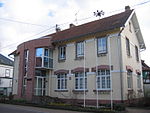Internationaux de Strasbourg
The Internationaux de Strasbourg (formally known as the Strasbourg Grand Prix) is a professional women's tennis tournament held in Strasbourg, France. It is an International-level outdoor event of the WTA Tour played on clay courts. The tournament has been organized in May since its inception in 1987 and serves as a warm-up event to the French Open which is played a week later.The tournament was played at the Hautepierre before moving to the Strasbourg’s Tennis Club in 2011.Past champions of the tournament include former world number ones Steffi Graf (singles), Jennifer Capriati (singles), Lindsay Davenport (two singles, one doubles), Maria Sharapova (singles), Angelique Kerber (singles), Martina Navratilova (doubles), and Ashleigh Barty (two doubles). The current champion is the German Angelique Kerber, having defeated the Slovenian Kaja Juvan in three sets.
Excerpt from the Wikipedia article Internationaux de Strasbourg (License: CC BY-SA 3.0, Authors).Internationaux de Strasbourg
Rue Baden Powell, Strasbourg Hautepierre
Geographical coordinates (GPS) Address Nearby Places Show on map
Geographical coordinates (GPS)
| Latitude | Longitude |
|---|---|
| N 48.598888888889 ° | E 7.6902777777778 ° |
Address
Ligue d'Alsace de Tennis
Rue Baden Powell
67205 Strasbourg, Hautepierre
Grand Est, France
Open on Google Maps










